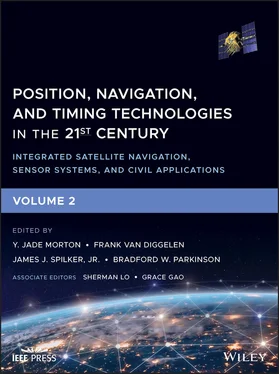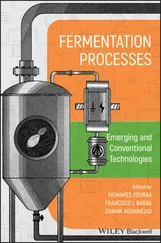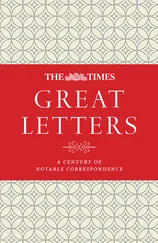As mentioned earlier in this introductory chapter, any measurement that changes when the sensor position changes can potentially be used as a navigation source. A good example of this is X‐ray pulsar‐based navigation which is described in Chapter 52, along with other variable celestial sources for navigation. The fundamental premise here is that if we can accurately measure the time of arrive of the periodic signal coming from several X‐ray‐emitting pulsars, we can use this information to determine our location. Additionally, methods for performing X‐ray pulsar‐based attitude determination are given.
In contrast to all of the technology‐based approaches describe thus far, Chapter 53focuses on brain neural processing in order to perform various navigation tasks. While these neurological approaches are quite difference from the approaches that engineers normally take to develop navigation systems, the way in which navigation is done by the brain suggest possibilities that we can attempt to implement with various forms of computing. Chapter 54further describes various ways in which animals are able to navigate and orient without the use of the modern sensors described elsewhere in this volume.
Volume 2 then concludes with several chapters that describe specific applications that make heavy use of navigation systems. Many of these applications did not exist prior to the arrival of GNSS, and those that did exist have seen large increases in capabilities by leveraging both GNSS and complementary navigation approaches.
The applications covered include survey and mobile mapping ( Chapter 55), precision agriculture ( Chapter 56), wearable navigation technology ( Chapter 57), driverless vehicles ( Chapter 58), train control ( Chapter 59), unmanned aerial systems ( Chapter 60), aviation ( Chapter 61), spacecraft navigation and orbit determination ( Chapter 62), spacecraft formation flying and rendezvous ( Chapter 63), and finally Arctic navigation ( Chapter 64).
Taken together, Volume 2 shows the incredible value of navigation systems and the variety of approaches that are available in cases where GNSS is not sufficient. Whether we realize it or not, our day‐to‐day lives are heavily dependent on the ability of many systems that interact with (or that are behind the scenes) to determine time and position, and there is an increasing number of creative options and opportunities for precise navigation and time that can meet the needs of current and future applications.
36 Nonlinear Recursive Estimation for Integrated Navigation Systems
Michael J. Veth
Veth Research Associates, United States
Almost immediately following its introduction in 1960, the Kalman filter and the extended Kalman filter have served as the primary algorithms used to solve navigation problems [1–3]. The optimal, recursive, and online characteristics of the algorithm are perfectly suited to serve a wide range of applications requiring real‐time navigation solutions.
The traditional Kalman filter and extended Kalman filter are based on the following assumptions:
Linear (or nearly linear) system dynamics and observations.
All noise and error sources are Gaussian.
While these assumptions are valid in many cases, there is increasing interest in incorporating sensors and systems that are non‐Gaussian, nonlinear, or both. Because these characteristics inherently violate the fundamental assumptions of the Kalman filter, when Kalman filters are used, performance suffers. More specifically, this can result in filter estimates that are inaccurate, inconsistent, or unstable. To address this limitation, researchers have developed a number of algorithms designed to provide improved performance for nonlinear and non‐Gaussian problems [4–6].
In this chapter, we provide an overview of some of the most common and useful classes of nonlinear recursive estimators. The goal is to introduce the fundamental theories supporting the algorithms, identify their associated performance characteristics, and finally present their respective applicability from a navigation perspective.
The chapter is organized as follows. First, an overview of the notation and essential concepts related to estimation and probability theory are presented as a foundation for nonlinear filtering development. Some of the concepts include recursive estimation frameworks, the implicit assumptions and limitations of traditional estimators, and the deleterious effects on performance when these assumptions are not satisfied. Next an overview of nonlinear estimation theory is presented with the goal of demonstrating and deriving three main classes of nonlinear recursive estimators. These include Gaussian sum filters, grid particle filters, and sampling particle filters. Each of these classes of nonlinear recursive estimators is demonstrated and evaluated using a simple navigation example. The chapter is concluded with a discussion regarding the strengths and weaknesses of the approaches discussed with an emphasis on helping navigation engineers decide which estimation algorithm to apply to a given problem of interest.
The following notation is used in this chapter:
State vector: The state vector at time k is represented by the vector xk.
State estimate: An estimated quantity is represented using the hat operator. For example, the estimated state vector at time k is .
A priori/a posteriori estimates: A priori and a posteriori estimates are represented using the + and – superscript notation. For example, the a priori state estimate at time k is , and the a posteriori state estimate at time k is .
State error covariance estimates: The state error covariance matrix is represented using the matrix P with superscripts and subscripts as required. For example, the a priori state error covariance matrix at time k is given by .
State transition matrix: The state transition matrix from time k – 1 to k is given by . Note that the time indices may be omitted when they are explained contextually.
Process noise vector and covariance: The process noise vector at time k is wk. The process noise covariance matrix at time k is Qk.
Observation vector: The observation vector at time k is given by zk.
Observation influence matrix: The observation influence matrix at time k is given by Hk. Note that the time index may be omitted when contextually unnecessary.
Measurement noise vector and covariance: The measurement noise vector at time k is represented by vk. The measurement noise covariance is represented by Rk.
Probability density function: Probability density functions are expressed as p(·).
36.2 Linear Estimation Foundations
The goal of any estimator is to estimate one (or more) parameters of interest based on a model of the system, observations from sensors, or both. Because the parameters are, by definition, random vectors, they can be completely characterized by their associated probability density function (pdf). If we define our parameter vector and observation vectors at time k as x kand z k, respectively, the overarching objective of a recursive estimator is to estimate the pdf of all of the previous state vector epochs, conditioned on all observations received up to the current epoch. Mathematically, this is expressed as the following pdf:
(36.1) 
where
(36.2) 
Читать дальше













